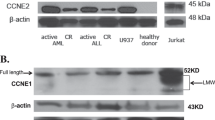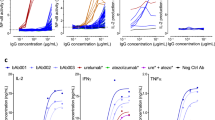Abstract
Mantle cell lymphoma (MCL) accounts for 5–10% of all non-Hodgkin lymphomas and has the worst prognosis among all lymphomas. The hallmark of MCL is a t(11;14) translocation that results in overexpression of cyclin D1 by tumor cells of virtually all patients. In this study, we examined whether cyclin D1 could be an effective tumor-associated antigen for immunotherapy. We identified cyclin D1 peptides for HLA-A*0201 and generated peptide-specific CD8+ T-cell lines from HLA-A*0201+ blood donors and MCL patients. These cell lines proliferated in response to cyclin D1 peptide-pulsed stimulatory cells. Moreover, the T cells efficiently lysed peptide-pulsed but not unpulsed T2 cells and autologous dendritic cells; cyclin D1+ and HLA-A*0201+ human MCL lines MINO, SP53, Jeko-1 and Granta 519; and more importantly, HLA-A*0201+ primary lymphoma cells from MCL patients. No killing was observed with HLA-A*0201− primary lymphoma cells or HLA-A*0201+ normal blood cells, including B cells. These results indicate that these T cells are potent cytotoxic T cells and recognize cyclin D1 peptides naturally presented by patient lymphoma cells in the context of HLA-A*0201 molecules. Taken together, our work identifies cyclin D1 as a potentially important antigen for immunotherapy of MCL.
This is a preview of subscription content, access via your institution
Access options
Subscribe to this journal
Receive 12 print issues and online access
$259.00 per year
only $21.58 per issue
Buy this article
- Purchase on Springer Link
- Instant access to full article PDF
Prices may be subject to local taxes which are calculated during checkout






Similar content being viewed by others
References
Pinyol M, Bea S, Pla L, Ribrag V, Bosq J, Rosenwald A et al. Inactivation of RB1 in mantle-cell lymphoma detected by nonsense-mediated mRNA decay pathway inhibition and microarray analysis. Blood 2007; 109: 5422–5429.
Zelenetz AD . Mantle cell lymphoma: an update on management. Ann Oncol 2006; 17 (Suppl 4): iv12–iv14.
Martin P, Leonard JP . Novel therapeutic targets in mantle cell lymphoma. Expert Opin Ther Targets 2007; 11: 929–940.
Evens AM, Winter JN, Hou N, Nelson BP, Rademaker A, Patton D et al. A phase II clinical trial of intensive chemotherapy followed by consolidative stem cell transplant: long-term follow-up in newly diagnosed mantle cell lymphoma. Br J Haematol 2008; 140: 385–393.
Bertoni F, Ponzoni M . The cellular origin of mantle cell lymphoma. Int J Biochem Cell Biol 2007; 39: 1747–1753.
Campo E, Raffeld M, Jaffe ES . Mantle-cell lymphoma. Semin Hematol 1999; 36: 115–127.
June CH . Adoptive T cell therapy for cancer in the clinic. J Clin Invest 2007; 117: 1466–1476.
Osterroth F, Garbe A, Fisch P, Veelken H . Stimulation of cytotoxic T cells against idiotype immunoglobulin of malignant lymphoma with protein-pulsed or idiotype-transduced dendritic cells. Blood 2000; 95: 1342–1349.
Schultze JL, Seamon MJ, Michalak S, Gribben JG, Nadler LM . Autologous tumor infiltrating T cells cytotoxic for follicular lymphoma cells can be expanded in vitro. Blood 1997; 89: 3806–3816.
Wen YJ, Barlogie B, Yi Q . Idiotype-specific cytotoxic T lymphocytes in multiple myeloma: evidence for their capacity to lyse autologous primary tumor cells. Blood 2001; 97: 1750–1755.
Kwak LW, Campbell MJ, Czerwinski DK, Hart S, Miller RA, Levy R . Induction of immune responses in patients with B-cell lymphoma against the surface-immunoglobulin idiotype expressed by their tumors. N Engl J Med 1992; 327: 1209–1215.
Franki SN, Steward KK, Betting DJ, Kafi K, Yamada RE, Timmerman JM . Dendritic cells loaded with apoptotic antibody-coated tumor cells provide protective immunity against B-cell lymphoma in vivo. Blood 2008; 111: 1504–1511.
Fernandez V, Hartmann E, Ott G, Campo E, Rosenwald A . Pathogenesis of mantle-cell lymphoma: all oncogenic roads lead to dysregulation of cell cycle and DNA damage response pathways. J Clin Oncol 2005; 23: 6364–6369.
Amin HM, McDonnell TJ, Medeiros LJ, Rassidakis GZ, Leventaki V, O’Connor SL et al. Characterization of 4 mantle cell lymphoma cell lines. Arch Pathol Lab Med 2003; 127: 424–431.
Jares P, Colomer D, Campo E . Genetic and molecular pathogenesis of mantle cell lymphoma: perspectives for new targeted therapeutics. Nat Rev Cancer 2007; 7: 750–762.
Klier M, Anastasov N, Hermann A, Meindl T, Angermeier D, Raffeld M et al. Specific lentiviral shRNA-mediated knockdown of cyclin D1 in mantle cell lymphoma has minimal effects on cell survival and reveals a regulatory circuit with cyclin D2. Leukemia 2008; 22: 2097–2105.
Romani N, Reider D, Heuer M, Ebner S, Kampgen E, Eibl B et al. Generation of mature dendritic cells from human blood. An improved method with special regard to clinical applicability. J Immunol Methods 1996; 196: 137–151.
Sallusto F, Lanzavecchia A . Efficient presentation of soluble antigen by cultured human dendritic cells is maintained by granulocyte/macrophage colony-stimulating factor plus interleukin 4 and downregulated by tumor necrosis factor alpha. J Exp Med 1994; 179: 1109–1118.
Anton D, Dabadghao S, Palucka K, Holm G, Yi Q . Generation of dendritic cells from peripheral blood adherent cells in medium with human serum. Scand J Immunol 1998; 47: 116–121.
Nijman HW, Houbiers JG, Vierboom MP, van der Burg SH, Drijfhout JW, D’Amaro J et al. Identification of peptide sequences that potentially trigger HLA-A2.1-restricted cytotoxic T lymphocytes. Eur J Immunol 1993; 23: 1215–1219.
Qian J, Xie J, Hong S, Yang J, Zhang L, Han X et al. Dickkopf-1 (DKK1) is a widely expressed and potent tumor-associated antigen in multiple myeloma. Blood 2007; 110: 1587–1594.
Qian J, Wang S, Yang J, Xie J, Lin P, Freeman ME et al. Targeting heat shock proteins for immunotherapy in multiple myeloma: generation of myeloma-specific CTLs using dendritic cells pulsed with tumor-derived gp96. Clin Cancer Res 2005; 11: 8808–8815.
Fulcher D, Wong S . Carboxyfluorescein succinimidyl ester-based proliferative assays for assessment of T cell function in the diagnostic laboratory. Immunol Cell Biol 1999; 77: 559–564.
Yi Q, Bergenbrant S, Osterborg A, Osby E, Ostman R, Bjorkholm M et al. T-cell stimulation induced by idiotypes on monoclonal immunoglobulins in patients with monoclonal gammopathies. Scand J Immunol 1993; 38: 529–534.
Yi Q, Osterborg A, Bergenbrant S, Mellstedt H, Holm G, Lefvert AK . Idiotype-reactive T-cell subsets and tumor load in monoclonal gammopathies. Blood 1995; 86: 3043–3049.
Tourdot S, Scardino A, Saloustrou E, Gross DA, Pascolo S, Cordopatis P et al. A general strategy to enhance immunogenicity of low-affinity HLA-A2. 1-associated peptides: implication in the identification of cryptic tumor epitopes. Eur J Immunol 2000; 30: 3411–3421.
Chen JL, Dunbar PR, Gileadi U, Jager E, Gnjatic S, Nagata Y et al. Identification of NY-ESO-1 peptide analogues capable of improved stimulation of tumor-reactive CTL. J Immunol 2000; 165: 948–955.
Tsomides TJ, Walker BD, Eisen HN . An optimal viral peptide recognized by CD8+ T cells binds very tightly to the restricting class I major histocompatibility complex protein on intact cells but not to the purified class I protein. Proc Natl Acad Sci USA 1991; 88: 11276–11280.
Dyall J, Latouche JB, Schnell S, Sadelain M . Lentivirus-transduced human monocyte-derived dendritic cells efficiently stimulate antigen-specific cytotoxic T lymphocytes. Blood 2001; 97: 114–121.
de Jong R, Brouwer M, Miedema F, van Lier RA . Human CD8+ T lymphocytes can be divided into CD45RA+ and CD45RO+ cells with different requirements for activation and differentiation. J Immunol 1991; 146: 2088–2094.
Cobb BS, Hertweck A, Smith J, O’Connor E, Graf D, Cook T et al. A role for Dicer in immune regulation. J Exp Med 2006; 203: 2519–2527.
Woodland DL, Dutton RW . Heterogeneity of CD4(+) and CD8(+) T cells. Curr Opin Immunol 2003; 15: 336–342.
Pulendran B, Dillon S, Joseph C, Curiel T, Banchereau J, Mohamadzadeh M . Dendritic cells generated in the presence of GM-CSF plus IL-15 prime potent CD8+ Tc1 responses in vivo. Eur J Immunol 2004; 34: 66–73.
Zhang Y, Renkvist N, Sun Z, Schuler-Thurner B, Glaichenhaus N, Schuler G et al. A polyclonal anti-vaccine CD4 T cell response detected with HLA-DP4 multimers in a melanoma patient vaccinated with MAGE-3.DP4-peptide-pulsed dendritic cells. Eur J Immunol 2005; 35: 1066–1075.
Berzofsky JA, Terabe M, Oh S, Belyakov IM, Ahlers JD, Janik JE et al. Progress on new vaccine strategies for the immunotherapy and prevention of cancer. J Clin Invest 2004; 113: 1515–1525.
Vonderheide RH, Hahn WC, Schultze JL, Nadler LM . The telomerase catalytic subunit is a widely expressed tumor-associated antigen recognized by cytotoxic T lymphocytes. Immunity 1999; 10: 673–679.
Vonderheide RH, Anderson KS, Hahn WC, Butler MO, Schultze JL, Nadler LM . Characterization of HLA-A3-restricted cytotoxic T lymphocytes reactive against the widely expressed tumor antigen telomerase. Clin Cancer Res 2001; 7: 3343–3348.
Schmitz M, Diestelkoetter P, Weigle B, Schmachtenberg F, Stevanovic S, Ockert D et al. Generation of survivin-specific CD8+ T effector cells by dendritic cells pulsed with protein or selected peptides. Cancer Res 2000; 60: 4845–4849.
Andersen MH, Pedersen LO, Becker JC, Straten PT . Identification of a cytotoxic T lymphocyte response to the apoptosis inhibitor protein survivin in cancer patients. Cancer Res 2001; 61: 869–872.
Pisarev V, Yu B, Salup R, Sherman S, Altieri DC, Gabrilovich DI . Full-length dominant-negative survivin for cancer immunotherapy. Clin Cancer Res 2003; 9: 6523–6533.
Gross DA, Graff-Dubois S, Opolon P, Cornet S, Alves P, Bennaceur-Griscelli A et al. High vaccination efficiency of low-affinity epitopes in antitumor immunotherapy. J Clin Invest 2004b; 113: 425–433.
Kuriyama H, Shimizu K, Lee W, Kjaergaard J, Parkhurst MR, Cohen PA et al. Therapeutic vaccine generated by electrofusion of dendritic cells and tumour cells. Dev Biol (Basel) 2004; 116: 169–178; discussion 179–186.
Otto K, Andersen MH, Eggert A, Keikavoussi P, Pedersen LO, Rath JC et al. Lack of toxicity of therapy-induced T cell responses against the universal tumour antigen survivin. Vaccine 2005; 23: 884–889.
Marzec M, Kasprzycka M, Lai R, Gladden AB, Wlodarski P, Tomczak E et al. Mantle cell lymphoma cells express predominantly cyclin D1a isoform and are highly sensitive to selective inhibition of CDK4 kinase activity. Blood 2006; 108: 1744–1750.
Witzig TE . Current treatment approaches for mantle-cell lymphoma. J Clin Oncol 2005; 23: 6409–6414.
Quelle DE, Ashmun RA, Shurtleff SA, Kato JY, Bar-Sagi D, Roussel MF et al. Overexpression of mouse D-type cyclins accelerates G1 phase in rodent fibroblasts. Genes Dev 1993; 7: 1559–1571.
Lu XL, Jiang XB, Liu RE, Zhang FC, Zhao HY . Generation of allo-restricted cytotoxic T lymphocytes against malignant glioma by artificial antigen-presenting cells. Cancer Lett 2007; 256: 128–135.
Coiffier B, Haioun C, Ketterer N, Engert A, Tilly H, Ma D et al. Rituximab (anti-CD20 monoclonal antibody) for the treatment of patients with relapsing or refractory aggressive lymphoma: a multicenter phase II study. Blood 1998; 92: 1927–1932.
McLaughlin P, Grillo-Lopez AJ, Link BK, Levy R, Czuczman MS, Williams ME et al. Rituximab chimeric anti-CD20 monoclonal antibody therapy for relapsed indolent lymphoma: half of patients respond to a four-dose treatment program. J Clin Oncol 1998; 16: 2825–2833.
Acknowledgements
We thank Alison Woo for providing editorial assistance. This work was supported by the institutional start-up funds from The University of Texas M.D. Anderson Cancer Center, National Cancer Institute Grants (R01 CA96569 and R01 CA103978), Commonwealth Foundation for Cancer Research and funds from the Crutchfield family and the Kimmel family philanthropic foundations.
Author information
Authors and Affiliations
Corresponding author
Rights and permissions
About this article
Cite this article
Wang, M., Sun, L., Qian, J. et al. Cyclin D1 as a universally expressed mantle cell lymphoma-associated tumor antigen for immunotherapy. Leukemia 23, 1320–1328 (2009). https://doi.org/10.1038/leu.2009.19
Received:
Revised:
Accepted:
Published:
Issue Date:
DOI: https://doi.org/10.1038/leu.2009.19
Keywords
This article is cited by
-
MYC: a multipurpose oncogene with prognostic and therapeutic implications in blood malignancies
Journal of Hematology & Oncology (2021)
-
A novel vaccine for mantle cell lymphoma based on targeting cyclin D1 to dendritic cells via CD40
Journal of Hematology & Oncology (2015)
-
Regulation of p21 by TWIST2 contributes to its tumor-suppressor function in human acute myeloid leukemia
Oncogene (2015)
-
Molecular profiling of blastic plasmacytoid dendritic cell neoplasm reveals a unique pattern and suggests selective sensitivity to NF-kB pathway inhibition
Leukemia (2014)
-
Identification of HLA ligands and T-cell epitopes for immunotherapy of lung cancer
Cancer Immunology, Immunotherapy (2013)



